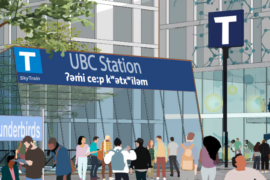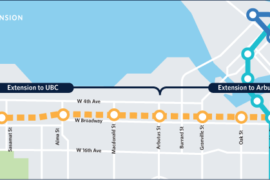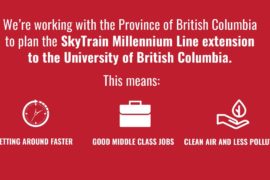Connecting the region with SkyTrain to UBC
Continuation of the Broadway Subway to UBC supports economic growth, affordability and sustainability by connecting research, health, innovation, employment and housing destinations. Learn more.
Five Reasons to Extend SkyTrain to UBC
- The Broadway Subway Project stops at Arbutus. Extending SkyTrain to UBC is the only way to avoid overcrowding and pass-ups on busses continuing to UBC.
- Solves the real, long-term transportation problem caused by the extraordinary volume of UBC-bound commuter traffic from across Metro Vancouver.
- Unlocks a significant amount of new car-light, transit-oriented development housing from Arbutus Street to UBC.
- Improves access to education, employment, and health care at UBC for people from across Metro Vancouver – one million people will be within a 60-minute transit trip to UBC.
- An economic stimulus for BC, creating thousands of long-term, high-paying, family supporting jobs and utilizing and showcasing BC and Canadian expertise and materials such as mass timber.
FAQ
Will the Broadway Subway go all the way to UBC?
No. The Broadway Subway ends at Arbutus Street. Transit riders heading to UBC will be required to transfer to B-Line and local route busses heading to UBC. It is anticipated that on opening day of the Broadway Subway UBC-bound ridership will exceed capacity so people will be waiting for space on B-Line busses when they get off of SkyTrain.
When will the UBC extension be built?
The Broadway Subway to Arbutus Street is expected to open by 2025. Planning and design for the completion of the extension to UBC could advance during construction of the first phase, leading to an opening day of 2030. This timeline assumes full funding commitments by all levels of government by 2021.
What is UBC’s vision for rapid transit to the Vancouver campus?
UBC envisions a seamless extension of the Broadway Subway to the UBC Vancouver campus. The University is engaging our community, regional partners and senior levels of government to determine the best way to accelerate and fund this second phase.





